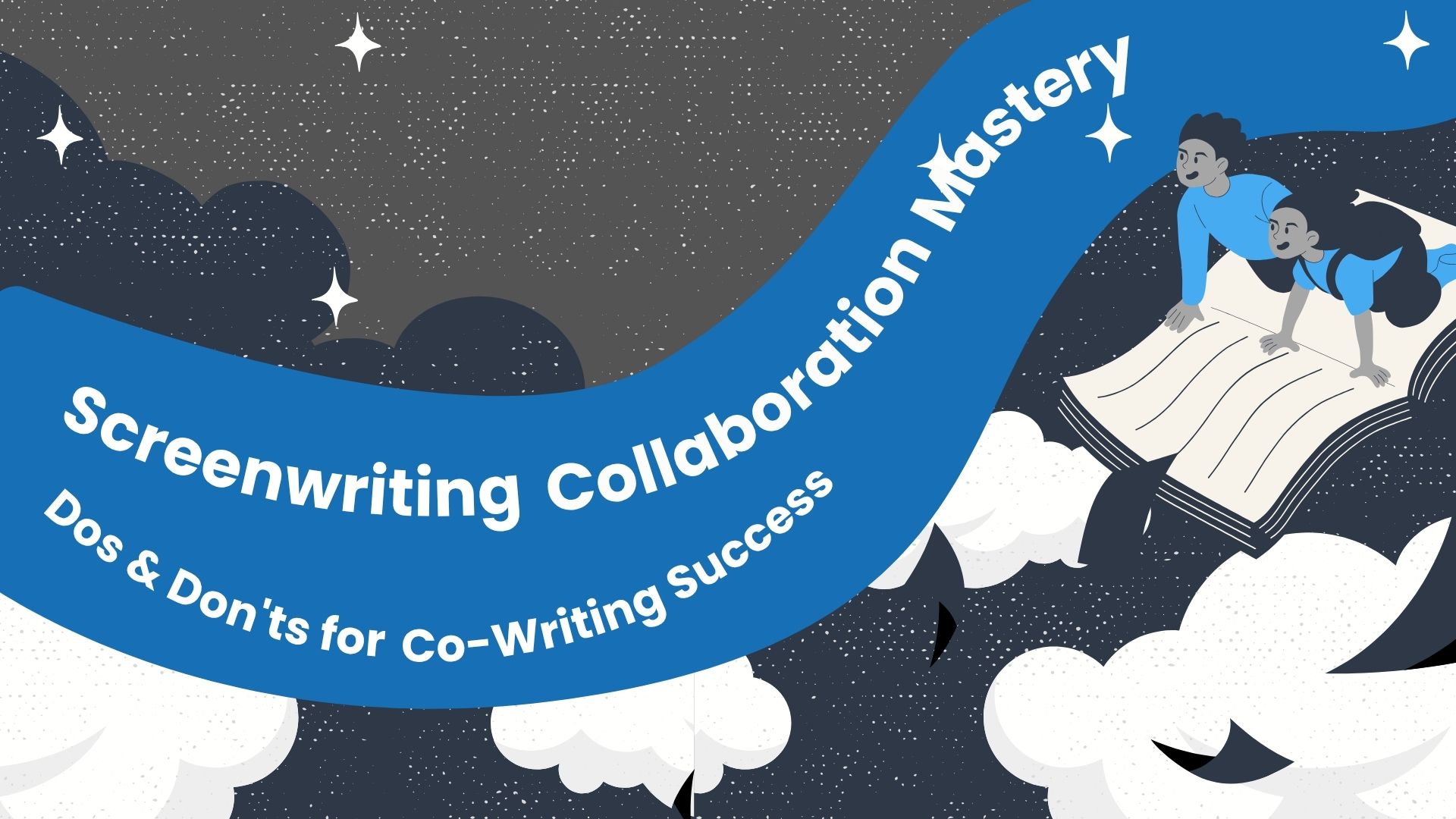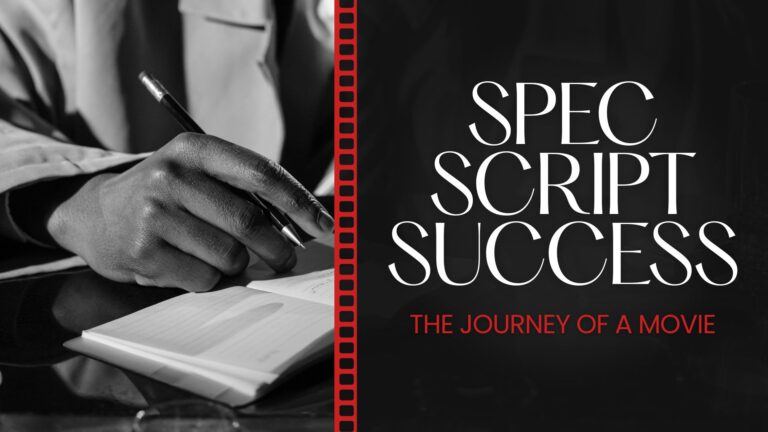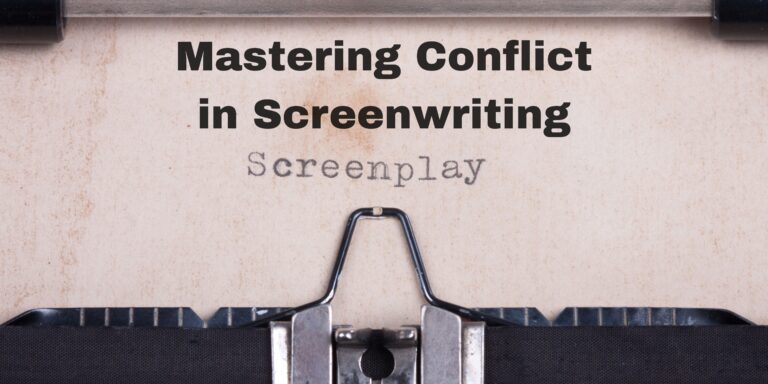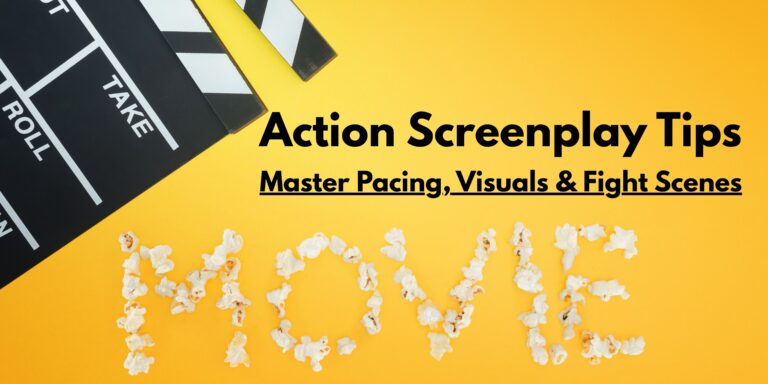Screenwriting Collaboration Mastery: Dos & Don’ts for Co-Writing Success
They say two heads are better than one, but in storytelling, two pens can either craft a masterpiece or clash like swords on paper.
Screenwriting collaboration is the art of weaving multiple creative minds into a single, seamless narrative: when in sync, the ship glides smoothly; when out of step, it risks running aground.
Each collaborator brings their own voice, rhythm, and lens to the story, blending diverse ideas into a single cinematic heartbeat.
Screenwriting collaboration isn’t just sharing the workload; it’s fusing strengths into a fabric of creativity. Dialogue sharpens, plot twists tighten, and worlds expand beyond what any single mind could conjure.
Like co-pilots navigating turbulence, collaborators steer the narrative through stormy drafts and dialogue whirlwinds, keeping the story aloft and on course.
But magic isn’t automatic. Without trust, clear communication, and a shared vision, even the most talented duo can clash like sparks in a powder keg of ideas.
Mastering screenwriting collaboration turns friction into fuel, challenges into stepping stones, and disparate ideas into a script that sings in harmony.
Fasten your seatbelts for a creative journey, screenwriting collaboration is more than teamwork; it’s an adventure that can elevate a draft from the page to the screen with cinematic precision.
Why Screenwriting Collaboration Matters
Screenwriting collaboration matters because it amplifies talent, divides the workload, and pushes creative boundaries.
When multiple minds converge on a single script, fresh perspectives emerge, dialogue sharpens, and plotlines gain unexpected richness.
It’s a process that fuels innovation: one writer spots a hole in the story, another offers a twist that elevates the tension, and together they craft scenes that resonate deeply.
Read more: Spec Script Success: Powerful Tips to Write One and Stand Out
But the magic of screenwriting collaboration isn’t automatic. Without trust, communication, and a shared vision, two pens can clash rather than blend.
Disagreements, misaligned priorities, and unclear roles can stall progress and dilute storytelling impact.
Embracing screenwriting collaboration means learning how to blend strengths, navigate creative friction, and keep the story front and center, turning potential chaos into screen magic.
With the right approach, screenwriting collaboration allows writers to challenge assumptions, refine ideas in real time, and transform individual brilliance into a script that’s richer, tighter, and unforgettable.
The payoff? A screenplay that feels alive, authentic, and ready to captivate audiences.

The Benefits of Screenwriting Collaboration
Imagine a room full of fireworks, each spark representing a unique idea, a fresh angle, or an unexpected twist.
That’s what screenwriting collaboration can feel like: a dynamic fusion of minds that transforms a simple story into a cinematic spectacle. Partnering with other writers doesn’t just divide the workload; it multiplies the creative potential.
At its core, screenwriting collaboration empowers writers to craft scripts that genuinely resonate with audiences.
By merging different perspectives, experiences, and storytelling techniques, collaborative teams can produce narratives with richer textures, deeper emotional arcs, and more relatable characters.
At Quilltowers, we’ve seen firsthand how partnerships on the page elevate scripts from competent drafts to engaging, memorable stories.
Creative Sparks Fly
When multiple writers come together, ideas bounce off the walls like pinballs in a classic arcade.
This fusion ignites creativity in ways that solo writing rarely can.
- Combining Varied Ideas: Different writing styles and perspectives collide, generating innovative concepts that surprise even the writers themselves. A quirky subplot, a compelling twist, or a richer character arc might emerge from this creative cross-pollination.
- Challenging Assumptions: Collaboration isn’t just about sharing ideas; it’s about sharpening them. When a partner questions your choices, it forces you to defend, refine, or rethink your approach, leading to a more polished and cohesive script.
Think of it as a creative gym: each challenge strengthens your storytelling muscles, leaving your screenplay leaner, more flexible, and ready for anything.
Many Voices, One Vision
Screenwriting collaboration introduces diversity, not just in ideas, but in lived experiences.
Writers from varied backgrounds bring insights that enrich character development and world-building.
- Broadened Storylines: With multiple perspectives, you can create multi-layered characters and complex storylines that appeal to a broader audience. Inclusivity isn’t an afterthought; it’s built into the story from the first draft.
- Cultural Accuracy: Collaborating with writers who understand specific cultures, communities, or subcultures ensures authenticity. The result? A screenplay that feels genuine and relatable, connecting with audiences on a deeper emotional level.
It turns your script into a seamless story, where each voice resonates beyond the screen.
Creative Solutions in Real Time
When plot problems or dialogue dilemmas arise, a collaborative team doesn’t get stuck; they pivot.
- Distributed Workloads: Each writer can focus on their strengths,some perfect pacing and structure, others hone dialogue, and a third polishes character motivations.
- Quick Resolutions: Collective brainstorming accelerates problem-solving. Narrative snags, plot holes, or pacing issues can be addressed immediately, keeping your project on schedule without sacrificing quality.
Collaboration, in this sense, acts like a well-oiled machine; everyone contributes to the gears turning smoothly toward a shared vision.
The Creative Echo Chamber
One of the most underrated benefits of screenwriting collaboration is the built-in feedback loop.
Immediate input from a partner keeps scripts evolving in real-time.
- Instantaneous Feedback: Constructive criticism flows freely, allowing writers to make tweaks before issues solidify.
- Iterative Improvements: Constant iteration creates a culture of continuous enhancement. Each pass refines the story, sharpens dialogue, and strengthens character arcs, preparing your script for both industry professionals and audience engagement.
In effect, collaborative writing becomes a cycle of learning and growth, a dynamic echo chamber where ideas are tested, refined, and elevated.
Read more: Sci-Fi Screenplay Tips: Make Worlds Feel Real
By embracing screenwriting collaboration, you don’t just share the load; you amplify creativity, problem-solving, and storytelling depth.
The result is a script that feels alive, vibrant, and meticulously crafted, ready to captivate audiences and stand out in the competitive world of filmmaking.

Screenwriting Collaboration: Choosing the Right Writing Partner
Finding the perfect writing partner is like assembling a puzzle: each piece has to fit seamlessly to reveal the bigger picture.
In screenwriting collaboration, the success of your project hinges on selecting partners whose skills, vision, and communication style complement your own.
The right pairing can turn a good script into a cinematic masterpiece; the wrong one can stall progress and fray nerves.
When Minds Meet, Magic Happens
- Shared Vision: Before pens hit paper, all collaborators must share a unified vision for the screenplay. Ask yourself: Do your creative goals align? If you’re chasing experimental storytelling while your partner prioritizes commercial appeal, sparks may fly, but not in a productive way.
- Creative Goals: Discuss the intended tone, audience, and narrative ambitions upfront. Aligning on these elements sets the foundation for smoother collaboration and a stronger, coherent final product.
Strength in Synergy
- Identifying Strengths: Every writer brings unique talents to the table, such as dialogue mastery, structural finesse, or emotional storytelling. Recognize each collaborator’s strengths and assign responsibilities accordingly.
- Balancing Weaknesses: Acknowledge your own gaps and seek partners who can fill them. Complementary skill sets transform a script from ordinary to extraordinary, allowing teams to cover all storytelling angles with precision.
Picture it like a jazz ensemble: when each musician plays their part in harmony, the composition comes alive, resonating with energy and depth.
Voices in Sync
- Effective Communication: Open and constructive dialogue is the heart of screenwriting collaboration. Miscommunication can derail progress, so establish channels and norms early.
- Formal and Informal Check-Ins: Regular meetings, shared documents, and even casual chats can maintain clarity and keep ideas flowing. Ensure your communication style suits all members to foster a positive, productive environment.
The Trust Factor
- Establish Trust: Trust is the cornerstone of any collaborative effort. Each writer should feel confident that their contributions, intellectual property, and creative rights are respected.
- Mutual Respect: Valuing every collaborator’s input promotes cohesion and morale. When respect underpins interactions, feedback becomes constructive, creativity thrives, and tension diminishes.
Choosing the right collaborators is more than a matter of skills; it’s about chemistry, shared ambition, and complementary energies.
The careful selection of partners lays the groundwork for a screenwriting collaboration that’s efficient, innovative, and deeply rewarding.
Setting Up the Screenwriting Collaboration Framework
Great screenwriting collaboration is like constructing a skyscraper: the taller and more impressive it becomes, the more critical the foundation.
Without a clear framework, even the most brilliant ideas can crumble under miscommunication or mismatched expectations.
Establishing roles, responsibilities, timelines, and agreements before the first scene is written ensures a productive, inspired, and harmonious partnership.
Lock It In: The Collaboration Pact
Start with a written agreement that outlines pay, credits, deadlines, and deliverables. Think of it as your project’s safety net.
Relying on a handshake alone is like building a set on quicksand; it won’t hold up under pressure.
A formal pact protects both friendship and creative investment, giving everyone the confidence to contribute boldly.
Role Call: Who Does What?
Clarify responsibilities upfront.
- Who takes the lead on dialogue?
- Who shapes story structure?
- How will revisions be split?
Defining these roles early prevents confusion and ensures collaboration flows smoothly. Whether it’s a 50/50 split or specialized assignments, everyone should know where their lane begins and ends.
Keep the Clock Rolling
Time is a writer’s most valuable currency. Establish a shared timeline for drafts, feedback sessions, and revisions.
Agree on milestones from beat sheets to first drafts and hold each other accountable. A well-planned schedule keeps momentum alive, transforming a chaotic process into a rhythmic creative journey.
Creative Chemistry
A strong partnership is more than the sum of its parts; it’s about synergy.
Choose a collaborator whose abilities complement yours and who communicates openly.
Honest feedback, receptive listening, and the willingness to challenge each other without ego form the spark that drives screenwriting collaboration from good to exceptional.
Story Over Self
Collaboration thrives when the story takes center stage. Mutual respect and trust turn a working arrangement into a true partnership.
Leave egos at the door; focus on crafting compelling scenes, not keeping score. When both writers prioritize the narrative above personal pride, creativity flows naturally, and the script flourishes.
Setting up a screenwriting collaboration framework isn’t bureaucracy; it’s the blueprint for creative freedom. Lay the groundwork right, and each draft becomes a smoother, more inspired ride toward cinematic success.
Working Together: Practical Screenwriting Collaboration Tips
Writing as a screenwriting duo is like a perfectly choreographed dance; each step matters, and timing is everything.
Screenwriting collaboration allows two creative minds to pool their strengths, spark ideas, and overcome obstacles more quickly than either could alone.
By combining talent, strategically dividing tasks, and maintaining momentum, your screenplay can evolve into a polished, high-impact project.
Two Talents, One Vision
Every partnership brings a unique mix of strengths to the table. One writer may shine in dialogue, while the other excels in plotting intricate story arcs.
By blending these complementary skills, you create a script that’s both tight and dynamic, appealing to broader audiences.
As industry professionals note, scripts crafted through thoughtful collaboration often reach higher creative and commercial standards.
When One Stalls, Two Soar
Writer’s block is a hurdle every screenwriter faces. Screenwriting collaboration acts as a creative safety net: when one mind hits a wall, the other can provide fresh ideas.
Brainstorming together sparks innovative concepts that might never surface when working solo.
Two perspectives often yield richer character development, sharper dialogue, and more inventive plot twists.
Draft in Sync, Finish Strong
Sharing the writing load ensures steady progress and high-quality output.
Consider dividing the script by scenes, characters, or even acts. One writer drafts while the other revises, creating a draft-revamp cycle that enhances the screenplay iteratively.
This method keeps the project moving, ensures consistent tone, and leverages each writer’s unique strengths.
Shared Deadlines, Shared Wins
Accountability multiplies when two writers collaborate.
Working as a duo naturally motivates both partners to meet deadlines and deliver polished work.
Shared ownership fosters commitment: each person feels responsible for maintaining the project’s quality and pace, ensuring a smoother workflow and fewer last-minute scrambles.
Divide and Conquer the Page
Smart task division prevents bottlenecks and maximizes creativity.
Here’s how top collaborative teams handle it:
- Scene Swap & Character Trade: Assign scenes or characters based on strengths. A partner skilled in action sequences can handle high-octane moments, while the other focuses on character-driven dialogue.
- Draft-Revamp Dance: Alternate drafts and revisions to capitalize on complementary abilities, one creates, the other polishes.
- Sync Up with Smart Tools: Platforms like Google Docs, Final Draft Collaborate, or WriterDuet allow real-time editing and commenting, keeping everyone aligned.
- Regular Check-Ins: Weekly or bi-weekly meetings help review progress, tackle challenges, and maintain creative cohesion.
Combine Creative Forces, Ignite Momentum
At its core, screenwriting collaboration is about synergy.
By pooling talents, sharing responsibilities, and communicating consistently, duos can produce scripts that are not only faster to complete but richer, more nuanced, and ultimately more compelling.
Two pens writing toward a single vision can transform a promising idea into a fully realized film-ready experience.

Communication & Conflict in Screenwriting Collaboration: Navigating Creative Differences
Even the best duos hit a bump in the road.
Screenwriting collaboration thrives on creativity, but it also brings inevitable differences in vision, style, and approach.
How you handle these moments can make or break the partnership. Like a well-oiled machine, every component, every voice must work in sync to keep the story moving forward.
Listen Like You Mean It
Active listening is more than hearing words; it’s absorbing intent and perspective.
Focus entirely on your partner’s ideas and concerns. Ask clarifying questions and summarize their points to ensure understanding.
This not only fosters mutual respect but also uncovers insights that can strengthen the screenplay. Empathy in communication turns friction into fertile ground for innovation.
Create, Don’t Compete
Collaboration is a blend, not a battle.
Embrace compromise and integrate elements from both viewpoints. Prioritize the screenplay over personal preferences. Often, the combination of two creative minds leads to solutions neither writer could have conceived alone.
When both partners keep the story above ego, conflict transforms into a creative opportunity.
Bring in Fresh Eyes
Sometimes, an impartial perspective is the key to untangling creative knots.
Consulting a mentor, colleague, or trusted script reader can provide clarity and unbiased feedback.
External input helps resolve disagreements and often sparks new ideas, keeping the screenplay moving forward without stalling in endless debates.
Story Above Ego
Let the narrative be your compass. When disputes arise, ask, “Which choice best serves the story?”
Keeping the story’s integrity front and center ensures that decisions are objective and collaborative rather than personal.
Ego is the enemy; the screenplay is the prize.
Edit Like a Unit
Revision is where collaborative screenwriting truly shines. A structured approach to editing allows both writers to refine the script efficiently without stepping on each other’s toes.
- Iterate and Elevate: Exchange drafts regularly and provide constructive feedback. Continuous feedback loops ensure improvements are integrated seamlessly.
- Merge Your Insights: Take notes independently, then discuss them together. Different viewpoints highlight blind spots and polish every aspect of the screenplay.
- Play to Your Strengths: Divide editing tasks according to skill; one partner may excel at tightening dialogue, while the other perfects plot arcs. This ensures expert attention across all script elements.
- Speak as One: Maintain a unified voice. Blend writing styles to preserve tone, pacing, and narrative flow. Regular joint reviews prevent inconsistencies and create a seamless final product.
Turn Conflict into Creativity
Conflict is not the enemy; it’s a catalyst when managed wisely.
By listening actively, prioritizing the story, leveraging strengths, and inviting outside perspectives, screenwriting duos can transform disagreements into breakthroughs.
In collaborative screenwriting, navigating creative differences is less about compromise and more about crafting a screenplay that’s sharper, richer, and more compelling than either writer could achieve alone.

Co-Writing Commandments: What to Do and What to Dodge
In screenwriting collaboration, knowing the do’s and don’ts is like having a map in uncharted territory: it keeps you on course, avoids pitfalls, and ensures your story reaches its destination intact.
Every writing duo can benefit from clear rules and actionable best practices.
Here’s a structured guide to keep your partnership strong and your screenplay sharp.
Define Roles & Decision Authority
- Do: Establish who leads on plot, dialogue, and final decisions. Clarity prevents overlap and friction.
- Don’t: Leave roles vague. Ambiguity is a breeding ground for misunderstandings and stalled progress.
Establish a Shared Vision & Goals
- Do: Align on tone, theme, stakes, and timelines before typing a word.
- Don’t: Start writing without alignment. Divergent visions produce a script with inconsistent voice and structure.
Leverage Collaboration Tools & Systems
- Do: Use real-time software such as WriterDuet or Celtx, and track versions carefully.
- Don’t: Neglect organization. A chaotic workflow can undermine even the most brilliant ideas.
Schedule Regular Check-Ins
- Do: Hold regular reviews to keep both writers accountable and in sync.
- Don’t: Ignore issues until they fester. Minor disagreements left unchecked can derail your project.
Give & Receive Feedback Graciously
- Do: Offer constructive critiques focused on story improvement.
- Don’t: Take every note personally. Letting ego interfere hampers collaboration and script quality.
Distribute Work Strategically
- Do: Assign tasks based on strengths, one handles structure, another nails dialogue.
- Don’t: Force equal contribution in every area. Doing everything together often slows momentum.
Document Agreements in Writing
- Do: Get credits, compensation, and exit strategies down on paper.
- Don’t: Rely on verbal promises. Unrecorded agreements can lead to messy disputes.
Maintain a Unified Voice
- Do: Reconcile style during rewrites so the script reads as a single, cohesive voice.
- Don’t: Let disjointed tone or style slip through. Inconsistent voices confuse readers and audiences.
Plan for Conflict
- Do: Define how disagreements will be resolved, third-party mediation, vote, or designated lead.
- Don’t: Pretend conflicts won’t happen. Unresolved disputes derail projects faster than missed deadlines.
Review & Revise Together
- Do: Share notes, iterate collectively, and polish as a team.
- Don’t: Skip joint revisions. Letting one partner polish alone risks diluting the “co” in co-writing.
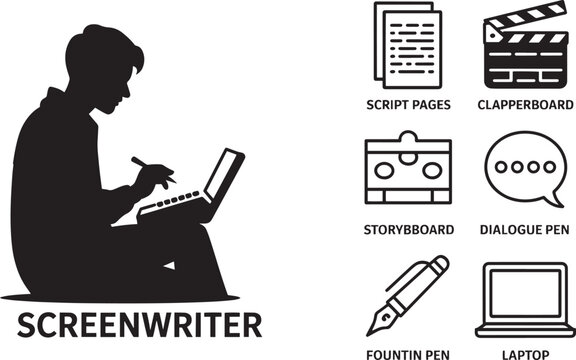
Tools and Platforms for Collaborative Screenwriting
In screenwriting collaboration, having the right tools is like giving each writer a finely tuned instrument: it amplifies creativity, harmonizes workflow, and ensures every note hits its mark.
Technology has revolutionized co-writing, making it possible for teams to brainstorm, draft, and revise in real time, no matter the distance.
Choosing the right platform can be the difference between chaos and cinematic magic.
WriterDuet: Real-Time Collaboration at Your Fingertips
WriterDuet is a powerhouse platform explicitly built for collaborative screenwriting.
- Live Editing: Multiple writers can simultaneously edit the same script and see changes as they happen.
- Integrated Communication: Built-in video and text chat keep ideas flowing without switching apps.
- Immediate Feedback: Instant suggestions and revisions mean your creative sparks aren’t lost in translation.
Whether you’re in the same room or across the globe, WriterDuet ensures that the team moves as one, keeping the story alive and evolving in real time.
Celtx: Structured Collaboration for Larger Projects
Celtx goes beyond writing; it’s a complete production companion for serious screenwriting duos and teams.
- Comprehensive Scriptwriting Tools: Centralized storyboarding, budgeting, and scheduling help manage complex projects.
- Version Tracking: Every revision is documented and accessible, reducing confusion over changes.
- Project Management: Assign tasks, track progress, and maintain accountability across your team.
For projects with multiple layers, plot arcs, characters, and production logistics, Celtx keeps everything organized and on schedule.
Google Docs: Simplicity Meets Accessibility
Sometimes, the best tool is the one everyone already knows. Google Docs remains a reliable choice for collaborative screenwriting, especially for teams seeking a simple solution.
- Ease of Access: Anyone with a link can contribute or review, making it beginner-friendly.
- Real-Time Feedback: Comment, suggest edits, or highlight areas for improvement directly in the document.
- Secure Permissions: Control who can view, edit, or comment to maintain script integrity.
Google Docs may not have all the bells and whistles of WriterDuet or Celtx, but it’s perfect for streamlined collaboration and quick iterations.
Choosing the Right Tool for Your Team
Every screenwriting partnership is unique.
The ideal platform should match your workflow, project size, and team preferences. A few key tips:
- Match the platform to your collaboration style. Are you detail-oriented or idea-driven?
- Ensure ease of communication to avoid bottlenecks.
- Keep track of revisions to preserve creative integrity.
Leveraging the right tools in screenwriting collaboration enhances productivity, fosters creativity, and provides the structure needed to transform ideas into a polished, compelling screenplay.
With the right platform, your writing team can focus less on logistics and more on storytelling brilliance.
Mastering the Co-Write
Navigating screenwriting collaboration is like steering a ship through both calm seas and turbulent waters; momentum, clarity, and teamwork are your guiding stars.
Read more: Action Screenplay Tips: Master Pacing, Visuals & Fight Scenes
Successful co-writing requires deliberate strategies to maintain creativity while keeping the project on course.
At Quilltowers, our experience with script development shows that intentional collaboration elevates a screenplay’s depth, polish, and impact.
Clarity Before Creativity
Before the first word hits the page, establish clear objectives to keep the project cohesive.
- Outline the Endgame: Define the purpose of your screenplay, keeping your target audience and the story’s ultimate arc in mind. Clear goals prevent wandering narratives and creative misfires.
- Own Your Lane: Assign roles based on each writer’s strengths. If one excels in dialogue and the other in plot structure, leveraging these talents prevents overlap and maximizes efficiency.
A shared understanding of direction ensures creativity doesn’t drift into chaos.
Talk It Out
Communication is the core of collaborative screenwriting. Without it, even the strongest team can falter.
- Stay Aligned: Schedule consistent check-ins to discuss progress, challenges, and next steps. Keeping everyone in the loop avoids misunderstandings and keeps the project on track.
- Speak, Share, Strengthen: Foster open dialogue and constructive feedback. A collaborative environment thrives when ideas are exchanged freely and refined collectively.
By talking it out, teams turn potential friction into creative fuel.
Structure for Success
A well-defined workflow is the scaffold on which great screenplays are built.
- Power Up with Tools: Utilize platforms like WriterDuet or Celtx to streamline tasks, track changes, and manage timelines. Proper tools transform collaboration from a juggling act into a synchronized performance.
- Celebrate the Checkpoints: Break the screenplay into milestones. Recognize small wins along the way; this helps maintain morale, motivation, and creative energy.
Structured collaboration ensures your co-writing process flows smoothly, even under tight deadlines.

The Takeaway
Perfecting screenwriting collaboration isn’t about eliminating conflict or spontaneity; it’s about channeling creativity through clarity, communication, and structure.
Teams that align goals, maintain open dialogue, and implement strategic workflows consistently produce scripts that are sharper, more cohesive, and emotionally resonant.
By combining vision with organization, collaborative writing becomes not just productive but transformative.
Turn Friction into Fuel
Even the most harmonious writing duos encounter friction. The key is turning creative sparks into productive fire rather than letting disagreements burn bridges.
Manage Creative Conflicts
Divergent ideas are inevitable, and often valuable.
- Dialogue, Not Discord: Encourage team members to voice their opinions openly while actively listening. Respectful discussion sparks innovative problem-solving.
- Find Common Ground: Seek consensus when conflicts arise, but remain ready to compromise. Prioritize advancing the story over individual preferences to keep the project moving.
Sync the Schedules
Timing can make or break collaborative momentum.
- Schedule with Agility: Adopt flexible planning that accommodates everyone’s availability. Digital calendars and shared timelines ensure meetings and deadlines stay on track.
- Tackle Priorities First: Focus on high-priority tasks first, keeping the project on schedule even when unforeseen obligations arise.
Share the Load Smartly
Uneven workloads can quickly derail collaboration.
- Share Tasks Strategically: Distribute responsibilities based on each collaborator’s strengths and expertise. Avoid overburdening any single team member.
- Review and Rebalance: Periodically assess workload distribution and adjust as needed to maintain fairness and efficiency.
Addressing challenges head-on fosters a resilient, high-functioning team that can navigate the pressures of collaborative screenwriting with confidence.
Collaboration that Clicks
Studying successful screenwriting teams reveals the secret sauce of effective collaboration: shared vision, mutual respect, and complementary skills.
- The Coen Brothers: Joel and Ethan Coen excel by integrating responsibilities seamlessly, revising scripts together and making joint creative decisions.
- Unified Vision: Their aligned storytelling mindset strengthens the narrative and their signature style.
- Balanced Brilliance: Each brings unique strengths, from dialogue to overarching structure, producing cohesive, critically acclaimed films like Fargo and No Country for Old Men.
- Tina Fey & Robert Carlock: The duo behind 30 Rock demonstrates how television writers thrive collaboratively.
- Creative Equilibrium: Mutual respect allows them to balance ideas and humor effectively.
- Quickfire Creativity: Real-time brainstorming enables agile adjustments and innovative solutions under pressure.
These examples prove that when collaboration clicks, the results are cinematic magic.
Navigating a screenwriting partnership is all about turning creative friction into fuel. From managing differing ideas to syncing schedules and distributing tasks effectively, successful teams transform challenges into breakthroughs.
Read more: Elevate Your Script with Impactful Voiceover in Screenplays
The journeys of the Coen Brothers and Tina Fey & Robert Carlock illustrate how shared vision, mutual respect, and complementary skills elevate a project from good to extraordinary.
From Two Pens to One Epic Script
Don’t just share pages, set your story ablaze.
Quilltowers turns screenwriting collaboration into a creative powerhouse, guiding your team from brainstorming to final polish.
Team up with Quilltowers and watch your screenplay roar to life.
